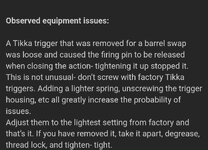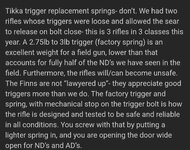Posting this so more people might see it and consider leaving the factory spring alone.
I just got back from the S2H Winter course where I shot a Tikka RSS 223. I like a light trigger so I chose to try replacing the factory trigger spring with a lighter trigger spring.
On day 6 I had a accidental discharge when I closed the bolt. Fortunately it was rnd 3 on target during an exercise. Running the bolt hard and fast I believe exaggerates the failure earlier than if it is run less aggressively.
Form confirmed failure by running the bolt 15-20 times and had another failure, rifle unloaded of course.
After experiencing this, I think it is simply spring fatigue. The lighter spring is a noticeably smaller guage wire.
After replacing my spring, everything was assembled with paint pen, no the trigger body wasnt loose.
Then I shot probably 400 rnds trying different bullets, zeroing the scope and testing a couple other things before the Winter course. During the course I shot around 900 rnds and plenty of dry fires.
Up to point of failure, probably 2000+ cycles. after failure, maybe 150 more.
Upon install, I set it at 2lb. After failure I tightened the screw one full turn to finish the last day, as of now, it is again at 2lb!
All springs have a duty life or number of cycles they are good for. If these springs are only "safe" for 1000 cycles (if at all) I'm out. I don't want to have to wonder if the next time I close the bolt it will go off or tear the rifle apart every x number of rounds and replace the spring again.
FWIW, I definitely agree with Form that replacing the factory spring is unnecessary and very likely dangerous. He has seen several others do the same thing.
I just got back from the S2H Winter course where I shot a Tikka RSS 223. I like a light trigger so I chose to try replacing the factory trigger spring with a lighter trigger spring.
On day 6 I had a accidental discharge when I closed the bolt. Fortunately it was rnd 3 on target during an exercise. Running the bolt hard and fast I believe exaggerates the failure earlier than if it is run less aggressively.
Form confirmed failure by running the bolt 15-20 times and had another failure, rifle unloaded of course.
After experiencing this, I think it is simply spring fatigue. The lighter spring is a noticeably smaller guage wire.
After replacing my spring, everything was assembled with paint pen, no the trigger body wasnt loose.
Then I shot probably 400 rnds trying different bullets, zeroing the scope and testing a couple other things before the Winter course. During the course I shot around 900 rnds and plenty of dry fires.
Up to point of failure, probably 2000+ cycles. after failure, maybe 150 more.
Upon install, I set it at 2lb. After failure I tightened the screw one full turn to finish the last day, as of now, it is again at 2lb!
All springs have a duty life or number of cycles they are good for. If these springs are only "safe" for 1000 cycles (if at all) I'm out. I don't want to have to wonder if the next time I close the bolt it will go off or tear the rifle apart every x number of rounds and replace the spring again.
FWIW, I definitely agree with Form that replacing the factory spring is unnecessary and very likely dangerous. He has seen several others do the same thing.


